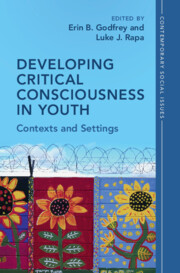Book contents
- Developing Critical Consciousness in Youth
- Contemporary Social Issues Series
- Developing Critical Consciousness in Youth
- Copyright page
- Dedication
- Contents
- Figures
- Tables
- Contributors
- Acknowledgments
- Introduction
- Part I Pedagogical, Curricular, and School-Based Contexts
- Part II Extracurricular Contexts
- 4 Re-envisioning the “Big Three” of Out-of-School Time Programs to Promote Critical Consciousness Development in Youth of Color
- 5 Breaking Down the Arts
- 6 “Listening is Where Love Begins” Advocacy for System-Impacted Youth as a Setting of Critical Consciousness Development
- Part III Societal Contexts
- Index
- References
6 - “Listening is Where Love Begins” Advocacy for System-Impacted Youth as a Setting of Critical Consciousness Development
from Part II - Extracurricular Contexts
Published online by Cambridge University Press: 11 May 2023
- Developing Critical Consciousness in Youth
- Contemporary Social Issues Series
- Developing Critical Consciousness in Youth
- Copyright page
- Dedication
- Contents
- Figures
- Tables
- Contributors
- Acknowledgments
- Introduction
- Part I Pedagogical, Curricular, and School-Based Contexts
- Part II Extracurricular Contexts
- 4 Re-envisioning the “Big Three” of Out-of-School Time Programs to Promote Critical Consciousness Development in Youth of Color
- 5 Breaking Down the Arts
- 6 “Listening is Where Love Begins” Advocacy for System-Impacted Youth as a Setting of Critical Consciousness Development
- Part III Societal Contexts
- Index
- References
Summary
Research has established critical consciousness (CC) as an important developmental competency, yet less is known about how to promote it, particularly for privileged youth. Service-learning experiences hold promise as context of CC development, but more research is needed to understand if they foster CC, for whom, and under what circumstances. This study examines the development of CC within what we term a critical service learning experience: the Resilience, Opportunity, Safety, Education, and Strength (ROSES) advocacy program. We connect specific features of this experience to expected growth in CC components among a group of educationally privileged university students serving as advocates for juvenile legal system-impacted girls. We delineate how engagement with ROSES is likely to influence critical consciousness among advocates themselves, then leverage exploratory data from advocates to empirically examine changes in CC over the course of ROSES. We examine changes in advocates’ interpersonal skills, critical reflection, critical motivation, and critical action as a result of participation in ROSES. We discuss patterns in these findings and examine how key characteristics of advocacy intervention implementation influenced skill development. We end by theorizing further on mechanisms of change in CC due to ROSES program participation and other service learning experiences.
Keywords
- Type
- Chapter
- Information
- Developing Critical Consciousness in YouthContexts and Settings, pp. 155 - 192Publisher: Cambridge University PressPrint publication year: 2023



